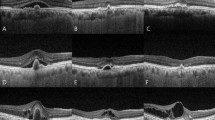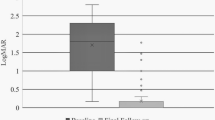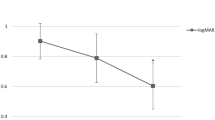Abstract
Purpose
To evaluate the long-term visual outcomes of pars plana vitrectomy (PPV) for polypoidal choroidal vasculopathy (PCV)-associated vitreous haemorrhage (VH).
Method
We retrospectively reviewed the records of patients with PCV-related VH who underwent PPV. The main outcome measures were best-corrected visual acuity (BCVA) and fundus findings at 3 months postoperatively and final visit.
Results
Seventeen eyes of 17 patients with massive subretinal haemorrhage (16.7±7.1 disc size of mean subretinal haemorrhage area) were enrolled. The mean postoperative follow-up period was 25.2 months. Four eyes received intravitreal bevacizumab injections, and three eyes underwent photodynamic therapy before the onset of VH. The mean BCVA improved from logarithm of the minimum angle of resolution (LogMAR) of 2.63±0.57 preoperatively to 1.43±0.82 at final visit (P<0.001). Among the eyes with initial polyps at subfoveal or juxtafoveal area, 16.70% achieved final BCVA ≥20/400 (LogMAR 1.3), whereas 87.50% of eyes with initial polyps at extrafoveal area had final BCVA ≥20/400 (Fisher’s exact test, P=0.026).
Conclusions
PCV with massive subretinal haemorrhage is at risk for breakthrough VH. The visual prognosis in eyes with PCV-related breakthrough VH is variable after vitrectomy. Initial polyps at the extrafoveal area led to better functional outcomes. Early vitrectomy may be beneficial for visual recovery after PCV-related VH.
Similar content being viewed by others
Log in or create a free account to read this content
Gain free access to this article, as well as selected content from this journal and more on nature.com
or
References
Yannuzzi LA, Sorenson J, Spaide RF, Lipson B . Idiopathic polypoidal choroidal vasculopathy (IPCV). Retina 1990; 10 (1): 1–8.
Kleiner RC, Brucker AJ, Johnston RL . The posterior uveal bleeding syndrome. Retina 1990; 10 (1): 9–17.
Stern RM, Zakov ZN, Zegarra H, Gutman FA . Multiple recurrent serosanguineous retinal pigment epithelial detachments in black women. Am J Ophthalmol 1985; 100 (4): 560–569.
Spaide RF, Yannuzzi LA, Slakter JS, Sorenson J, Orlach DA . Indocyanine green videoangiography of idiopathic polypoidal choroidal vasculopathy. Retina 1995; 15 (2): 100–110.
Sho K, Takahashi K, Yamada H, Wada M, Nagai Y, Otsuji T et al. Polypoidal choroidal vasculopathy: incidence, demographic features, and clinical characteristics. Arch Ophthalmol 2003; 121 (10): 1392–1396.
Kwok AK, Lai TY, Chan CW, Neoh EL, Lam DS . Polypoidal choroidal vasculopathy in Chinese patients. Br J Ophthalmol 2002; 86 (8): 892–897.
Uyama M, Wada M, Nagai Y, Matsubara T, Matsunaga H, Fukushima I et al. Polypoidal choroidal vasculopathy: natural history. Am J Ophthalmol 2002; 133 (5): 639–648.
Hou J, Tao Y, Li XX, Zhao MW . Clinical characteristics of polypoidal choroidal vasculopathy in Chinese patients. Graefes Arch Clin Exp Ophthalmol 2011; 249 (7): 975–979.
Chan WM, Lam DS, Lai TY, Liu DT, Li KK, Yao Y et al. Photodynamic therapy with verteporfin for symptomatic polypoidal choroidal vasculopathy: one-year results of a prospective case series. Ophthalmology 2004; 111 (8): 1576–1584.
Cho HJ, Lee DW, Cho SW, Kim CG, Kim JW . Hemorrhagic complications after intravitreal ranibizumab injection for polypoidal choroidal vasculopathy. Can J Ophthalmol 2012; 47 (2): 170–175.
Ojima Y, Tsujikawa A, Otani A, Hirami Y, Aikawa H, Yoshimura N . Recurrent bleeding after photodynamic therapy in polypoidal choroidal vasculopathy. Am J Ophthalmol 2006; 141 (5): 958–960.
Hirami Y, Tsujikawa A, Otani A, Yodoi Y, Aikawa H, Mandai M et al. Hemorrhagic complications after photodynamic therapy for polypoidal choroidal vasculopathy. Retina 2007; 27 (3): 335–341.
Wu TT, Kung YH, Hong MC . Vitreous hemorrhage complicating intravitreal tissue plasminogen activator and pneumatic displacement of submacular hemorrhage. Retina 2011; 31 (10): 2071–2077.
Jung JH, Lee JK, Lee JE, Oum BS . Results of vitrectomy for breakthrough vitreous hemorrhage associated with age-related macular degeneration and polypoidal choroidal vasculopathy. Retina 2010; 30 (6): 865–873.
Jalali S, Parra SL, Majji AB, Hussain N, Shah VA . Ultrasonographic characteristics and treatment outcomes of surgery for vitreous hemorrhage in idiopathic polypoidal choroidal vasculopathy. Am J Ophthalmol 2006; 142 (4): 608–619.
Cackett P, Wong D, Yeo I . A classification system for polypoidal choroidal vasculopathy. Retina 2009; 29 (2): 187–191.
Holladay JT . Visual acuity measurements. J Cataract Refract Surg 2004; 30 (2): 287–290.
Ahuja RM, Stanga PE, Vingerling JR, Reck AC, Bird AC . Polypoidal choroidal vasculopathy in exudative and haemorrhagic pigment epithelial detachments. Br J Ophthalmol 2000; 84 (5): 479–484.
Tsujikawa A, Sasahara M, Otani A, Gotoh N, Kameda T, Iwama D et al. Pigment epithelial detachment in polypoidal choroidal vasculopathy. Am J Ophthalmol 2007; 143 (1): 102–111.
Tsujikawa A, Ojima Y, Yamashiro K, Nakata I, Ooto S, Tamura H et al. Association of lesion size and visual prognosis to polypoidal choroidal vasculopathy. Am J Ophthalmol 2011; 151 (6): 961–972 and 961.
Park DH, Kim IT . Association of ARMS2/HTRA1 variants with polypoidal choroidal vasculopathy phenotype in a Korean population. Jpn J Ophthalmol 2012; 56 (1): 60–67.
Chen H, Liu K, Chen LJ, Hou P, Chen W, Pang CP . Genetic associations in polypoidal choroidal vasculopathy: a systematic review and meta-analysis. Mol Vis 2012; 18: 816–829.
Sakurada Y, Kubota T, Mabuchi F, Imasawa M, Tanabe N, Iijima H . Association of LOC387715 A69S with vitreous hemorrhage in polypoidal choroidal vasculopathy. Am J Ophthalmol 2008; 145 (6): 1058–1062.
Uyama M, Matsubara T, Fukushima I, Matsunaga H, Iwashita K, Nagai Y et al. Idiopathic polypoidal choroidal vasculopathy in Japanese patients. Arch Ophthalmol 1999; 117 (8): 1035–1042.
Lip PL, Hope-Ross MW, Gibson JM . Idiopathic polypoidal choroidal vasculopathy: a disease with diverse clinical spectrum and systemic associations. Eye (Lond) 2000; 14 (Part 5): 695–700.
Nakata I, Tsujikawa A, Yamashiro K, Otani A, Ooto S, Akagi-Kurashige Y et al. Two-year outcome of photodynamic therapy combined with intravitreal injection of bevacizumab and triamcinolone acetonide for polypoidal choroidal vasculopathy. Graefes Arch Clin Exp Ophthalmol 2013; 251 (4): 1073–1080.
Tomita K, Tsujikawa A, Yamashiro K, Ooto S, Tamura H, Otani A et al. Treatment of polypoidal choroidal vasculopathy with photodynamic therapy combined with intravitreal injections of ranibizumab. Am J Ophthalmol 2012; 153 (1): 68–80, e61.
Sato T, Kishi S, Matsumoto H, Mukai R . Combined photodynamic therapy with verteporfin and intravitreal bevacizumab for polypoidal choroidal vasculopathy. Am J Ophthalmol 2010; 149 (6): 947–954, e941.
Gomi F, Sawa M, Wakabayashi T, Sasamoto Y, Suzuki M, Tsujikawa M . Efficacy of intravitreal bevacizumab combined with photodynamic therapy for polypoidal choroidal vasculopathy. Am J Ophthalmol 2010; 150 (1): 48–54, e41.
Bakri SJ, Kitzmann AS . Retinal pigment epithelial tear after intravitreal ranibizumab. Am J Ophthalmol 2007; 143 (3): 505–507.
Googe JM, Hirose T, Apple DJ, Melgen S . Vitreous hemorrhage secondary to age-related macular degeneration. Surv Ophthalmol 1987; 32 (2): 123–130.
Lincoff H, Madjarov B, Lincoff N, Movshovich A, Saxena S, Coleman DJ et al. Pathogenesis of the vitreous cloud emanating from subretinal hemorrhage. Arch Ophthalmol 2003; 121 (1): 91–96.
Orth DH, Flood TP . Management of breakthrough vitreous hemorrhage from presumed extramacular subretinal neovascularization. Retina 1982; 2 (2): 89–93.
Azzolini C, Menchini U, Pece A, Camesasca F, Giuliani V . Age-related macular degeneration and vitreous hemorrhage. Eur J Ophthalmol 1991; 1 (3): 142–147.
Roufail E, Polkinghorne PJ . Combined cataract surgery and vitrectomy for vitreous haemorrhage secondary to age-related macular degeneration. Clin Exp Ophthalmol 2008; 36 (1): 36–38.
Reynders S, Lafaut BA, Aisenbrey S, Broecke CV, Lucke K, Walter P et al. Clinicopathologic correlation in hemorrhagic age-related macular degeneration. Graefes Arch Clin Exp Ophthalmol 2002; 240 (4): 279–285.
Lee YA, Yang CH, Yang CM, Ho TC, Lin CP, Huang JS et al. Photodynamic therapy with or without intravitreal bevacizumab for polypoidal choroidal vasculopathy: two years of follow-up. Am J Ophthalmol 2012; 154 (5): 872–880, e2.
Author information
Authors and Affiliations
Corresponding author
Ethics declarations
Competing interests
The authors declare no conflict of interest.
Rights and permissions
About this article
Cite this article
Lin, HC., Yang, CH. & Yang, CM. Visual outcomes of vitrectomy for polypoidal choroidal vasculopathy-related breakthrough vitreous haemorrhage. Eye 28, 797–807 (2014). https://doi.org/10.1038/eye.2014.124
Received:
Accepted:
Published:
Issue date:
DOI: https://doi.org/10.1038/eye.2014.124
This article is cited by
-
Optical coherence tomography-based misdiagnosis and morphological distinction in pachychoroid neovasculopathy vs. polypoidal choroidal vasculopathy
Eye (2023)
-
Surgical outcomes of vitrectomy for breakthrough vitreous hemorrhage in eyes with exudative age-related macular degeneration
International Ophthalmology (2021)
-
Long-term Clinical Course after Vitrectomy for Breakthrough Vitreous Hemorrhage Secondary to Neovascular Age-related Macular Degeneration and Polypoidal Choroidal Vasculopathy
Scientific Reports (2020)
-
Vitreous haemorrhage in massive hemorrhagic polypoidal choroidal vasculopathy: clinical characteristics and surgical outcomes
International Journal of Retina and Vitreous (2015)



